Plans, Maps and Churches - Martha and Mary Convent of Saint Elizabeth Moscow
Martha-Mary Convent and rule of St. Elizabeth, the New Martyr
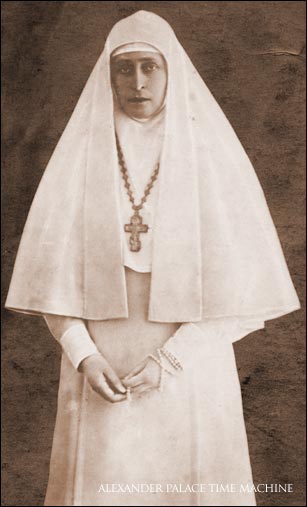 excerpt from
excerpt from
The Martha and Mary Convent
Holy Trinity Monastery
Printshop of St. Job of Pochaev
Jordanville, New York - 1991
First Printing - Moscow - Synodal Press - 1914
The Convent Staff
Superior:
Her Imperial Highness the Grand Duchess Elizabeth Feodorovna.
Spiritual Father:
Archpriest Mitrofan Strebtrensky.
Treasurer:
Valentina Sergeevna Gordieva.
Currently there are ninety-seven sisters in the community and each is assigned to one of the various obediences:
1-Starosta; 1-Secretary; l-household purchaser; 1-charity administrator; 27- ecclesiarch and choir (they also work in the craft shop); 5-prosphora bakers; 26-medical workers; 6-pharmacy staff; 3-orphanage staff; 5-refectory workers; 3-laundresses; 5-kitchen help; 2-cellattendants; 4- housecleaning staff; 2-guestmasters; 4-staff the dining hall for the poor; 1-lives in the home for factory workers.
Living close to the community is a second priest, Fr. Eugene Sinadsky, and a deacon, Fr. M. Citnik. The doctors of the community are under the supervision of Dr. A.I. Nikitin.
A DAY AT THE COMMUNITY
The sisters arise at 6:00 A.M. and organize their rooms. At 7:30 they gather in the hospital chapel for a common rule of prayer followed by the reading of a gospel, an epistle, a psalm, and perhaps a brief sermon by the priest serving that day. The sisters depart from the chapel after receiving a blessing from the priest and greeting the mother superior. They then gather for some tea before going to their daily obediences. Those not immediately needed at their obedience remain in the chapel for the Divine Liturgy.
Sisters are responsible for the reading and chanting in both churches. The chant is generally of a simple monastic style, with concert singing very seldom used. The choir members also do handiwork in the community workshop, where all the clothing of the sisters is made.
Following morning prayers, the sisters will be found at their various obediences: some in the hospital awaiting the doctors making rounds, others in the clinic to provide treatment such as massages, injections, etc., for the ailing, others in the school, and yet others in the kitchen or other areas of the house, all busy at their daily work.
Twice a week between the hours of 11:00 A.M. and 12:00 P.M. the spiritual father offers the sisters a lecture, one week on the catechism, and the following week one on the holy fathers. The sisters prepare for Holy Communion at least four times a year during the major fasts, though they may receive more often if they wish.
At 12:30 lunch is served with the reading of the life of the saint of the day during the meal. Meals are prepared in accordance with church fasting rules. Tea is served at 4:00P.M. followed by vespers and matins at 5:00 P.M. Sisters who have completed their obediences are present at these services. Before feast days and Sundays, all-night vigils are held. At 7:30 P.M. dinner is served. There is common evening prayer at 9:00 P.M. in the hospital chapel. The sisters retire to their cells following prayer, receiving a blessing from the superior as they depart. By 10:30 P.M. all prepare for sleep, and by 11:00 P.M. there is quiet and all lights are out.
For their spiritual strengthening and edification the sisters may visit with the Abbess or spiritual father at an appointed time.
Four times a week an akantist hymn is read during the evening prayer rule: on Sundays, to the Savior; Mondays, to Archangel Michael and all the Heavenly Hosts; Wednesdays, to Sts. Martha and Mary; and Fridays, to the Mother of God or the Passion of Christ.
The sisters are also obliged to attend Vigil and Liturgy at the Chudov Monastery on the feast days of the holy hierarch St. Alexis of Moscow, February 12 and May 20. A pilgrimage is also made to the sepulchre church of the Grand Duke Sergei Alexandrovich on February 4, the day of his repose.
The sisters wear white cotton robes on Sundays and feast days. The work uniform is a grey cotton robe cut like a cassock, sewn together in front and closed on the sides. with white cuffs on the sleeve The head covering of tonsured members is a white apostolnik cut in the monastic style with a grey woolen veil. Those tonsured also wear a cross made of cypress wood around their necks on a white string. The icons of Christ-Not-Made-By- Hands and the Protection of the Mother of God are on one side of the cross; the other side holds an icon of Sts. Martha and Mary and the inscription: Thou shalt Love the Lord thy God with all thy heart, and all your soul, and all thy mind, and all thy strength; Thou shalt love thy neighbor as thyself. Sisters receive this cross at their tonsure into the sisterhood, giving a vow to devote this specific period of their lives to God and neighbor, and to abide by the rules of the community.
All sisters are given a prayer rope upon entering the Community with the obligation to recite the Jesus Prayer 100 times daily. Postulants do not wear the prayer rope externally, but those tonsured wear the prayer rope they received a second time at their tonsure on their left hand. Postulants wear a long white kerchief on their heads, which covers their foreheads completely. On Sundays and feast days the sisters wear white robes. The postulants wear gray robes.
A primary obligation of the sisters is to visit the poor. A few sisters are sent out daily in pairs to visit assigned areas of the city. The Grand Duchess receives over twelve thousand petitions annually. A portion of these are reviewed by the sisters, processed along with the numerous other requests and information about the poor received from other sources. With God's help a way is i found to provide comfort, aid, and treatment for all. This work is done with love in the name of Christ, with the desire to offer even a small amount of good of which we are capable. This bit is the drop of water concerning which our Lord said: And whosoever shall give to drink unto one of these little ones a cup of cold water... he shall in no wise lose his reward (Matt. 10:42).
May the Lord help the Martha and Mary Community of Mercy continue its modest work in the Lord's field. And if, as we hope, good people will aid us, this work will progress and a small shrub will grow and blossom into a fruit bearing tree.
The sisters serve the Church and for this reason in times of war do not serve as Red Cross sisters. Their place is to tend to the sick and suffering of Moscow, and to offer assistance in case of epidemics or civic disasters. In time, if the Lord allows, a dependency of the community will be established for work outside of Moscow.
In the days of the first Christians, deaconesses were occupied with these works of charity. There were two kinds: 1) Ordained deaconesses assisted in the Church at; the Divine Services (Baptisms) and 2) Deaconesses, not ordained but distinguished by their dress, were employed in works of mercy. The sisters of The Martha-Mary Convent are numbered in the second category.
Eventually, the Martha-Mary Convent hopes to own itsown skete on the outskirts of Moscow where those sisters who have labored much, may with the permission of the community, be tonsured into the mantia and withdraw from an active life, in order to devote their remaining years exclusively to God.
The community will build a retirement home for elderly sisters and those who have, as mentioned above, require care after much service to the poor.
A BRIEF LIFE OF ST. ELIZABETH THE NEW MARTYR
Born in 1864, the Grand Duchess Elizabeth< was the second daughter of Grand Duke Louis IV of HesseDarmstadt. Her mother was Princess Alice of England, daughter of Queen Victoria. In 1884 she married Grand Duke Sergei Alexandrovitich, uncle of the last Czar of Russia, the New Martyr Nicholas II. In 1905 she was fated to witness her husband's brutal murder when a bomb was set off as he exited his front door. Rather than seek revenge on his murderer or pity herself Elizabeth acted with great moral strength and true forgiveness. She went to the prison cell of the murderer hoping that he would repent of his act that his immortal soul might be saved.
This experience wrought a decisive moral change in the soul of the Grand Duchess which caused her to forsake her former way of life. Having on her own initiative converted to the Orthodox faith in her seventh year of marriage, she now sought to devote herself entirely to the spiritual life.
Her vision was to create a community made up of women from all social strata that would merge the ideals of Saints Martha and Mary to achieve faith and love in service to others, and to achieve prayer in humility.
With the help of God St. Elizabeth saw her dream realized. She acquired a small property within the city of Moscow on which she constructed a hospital; an orphanage for girls; and quarters for the sisters. There was also a dining hall where 300 meals were served daily to the poor. In 1910 a separate church was built on the property dedicated to the Protection of the Mother of God.
While supervising the activities of the sisterhood, which at its peak numbered 97 sisters, St. Elizabeth also served as a shining example of selfless devotion to others and a true struggler in Orthodox piety. She slept no more than three to four hours a day on a wooden bed without a mattress. Her daily fare consisted of vegetables and milk, when fasting rules allowed. At midnight she would rise to pray and then make the rounds of the hospital visiting the bedsides of the most seriously ill and comforting them with her words.
This good and holy work was not to last long however. On Bright Tuesday, March 13,1918, with the coming of the Communist government, St. Elizabeth was forcibly taken from her convent and placed under arrest. As a member of the royal family and through the pious influence she had on the people she was considered to be the opposition and not to be trusted.
On the night of July 5/18,1918 St. Elizabeth, her cell attendant Barbara, who refused to leave St. Elizabeth's side upon her arrest though she knew it would mean her own death, and five members of the Royal Family were taken out of their place of confinement and thrown alive into a deep mine shaft. After a number of days the bodies were recovered and smuggled to China to escape desecration by the Bolsheviks. Ultimately, in 1920, the bodies of Sts. Elizabeth and Barbara were laid to rest in the Convent of St. Mary Magdalene in Gethsemane.
On October 19/November 1, 1981 Sts. Elizabeth and Barbara along with the multitudes who were killed by the Communists solely for their faith, were of ficially canonized by the Russian Orthodox Church Abroad. In preparation for the canonization the coffins of Sts. Elizabeth and Barbara were opened and the relics investigated. When St. Elizabeth's coffin was opened a wonderful aroma "like honey and jasmine mixed" filled the room. The hand of St. Elizabeth lies in a reliquary in the Synodal Cathedral of Our Lady of the Sign in New York City, allowing those in this country the opportunity to venerate her holy relics.
If one's eyes were directed only towards this world then there would remain little to remind us of the achievements of St. Elizabeth. By 1926 the Convent of Sts. Martha and Mary had been totally disbanded and its remaining members exiled to Central Asia. Their church was impiously converted into a social hall by the Communists and on the site of the altar table was placed a statue of Lenin. There is now a revival of the memory of St. Elizabeth in the Soviet Union and- pilgrims bring back news of restoration going on in the Convent. A statue has been erected in the courtyard of her convent with the inscription, "To The Grand Duchess Elizabeth. With Repentance."
In our hearts we know that St. Elizabeth has not forsaken this world. In venerating her memory and relics our spirit is renewed; in remembering her deeds many throughout the world are now inspired to similar virtues. Through her prayers faith is renewed and new members are added to the Holy Orthodox Church of Christ.
Bob Atchison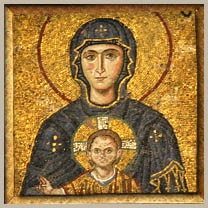




 Imperial Bedroom
Imperial Bedroom Portrait Hall
Portrait Hall Mauve Room
Mauve Room Maple Room
Maple Room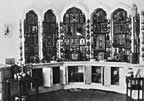 Aleksey's Bedroom
Aleksey's Bedroom Nicholas's Study
Nicholas's Study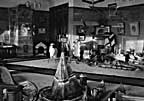 Aleksey's Playroom
Aleksey's Playroom Formal Reception
Formal Reception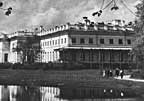 Balcony View
Balcony View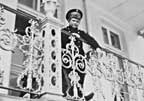 Aleksey- Balcony
Aleksey- Balcony Children-Mauve
Children-Mauve Nicholas's Bathroom
Nicholas's Bathroom Alexandra- Mauve
Alexandra- Mauve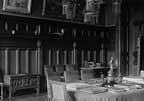 Nicholas's Reception
Nicholas's Reception Tsarskoe Selo Map
Tsarskoe Selo Map